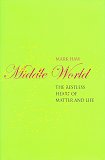"Middle World" is the world on a scale bigger than atoms, but smaller than everyday scales: the scale where Brownian motion is important, the scale where the macro-molecules of life are constantly jiggling and flexing, constantly in motion, constantly interacting.
Haw starts with Robert Brown's 1827 observations of pollen in the restless motion that has been given his name, and takes us on an historical tour to explain the process -- indeed, some of the more obscure subsequent observations still remain to be explained. Haw weaves the science and history together in a compelling tale, and by the end, the science is dominating, being shown to be crucial to the understanding of life, and being shown to be rather counterintuitive to our somewhat rigid and mechanistic thinking based on our intuitions of "large" structures.
This is an interesting introduction to the subject, which much to whet the appetite, and a good list of further reading for those who want to go further.
